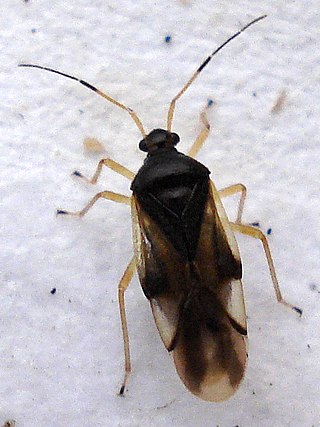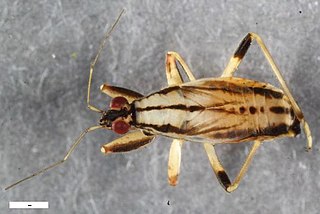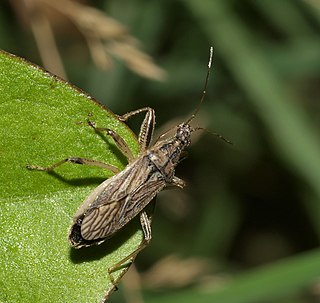
The Pentatomoidea are a superfamily of insects in the suborder Heteroptera of the order Hemiptera. As hemipterans, they possess a common arrangement of sucking mouthparts. The roughly 7000 species under Pentatomoidea are divided into 21 families. Among these are the stink bugs and shield bugs, jewel bugs, giant shield bugs, and burrower bugs.

Nabis flavomarginatus is a species of damsel bug in the family Nabidae.

Nabis limbatus is a species of damsel bug in the family Nabidae. It is found in Northern Europe and the northern part of Western and Central Europe. It occurs in the East in Eastern Europe and across the Palearctic to Siberia to China and Korea. It is introduced in Canada. In the Alps, it rises to about 1400 meters above sea level. In the South of Europe, it is found only in the central uplands.

Canthophorus dubius is a species of burrowing bug belonging to the family Cydnidae, subfamily Sehirinae.

Stagonomus venustissimus, common name woundwort shieldbug, is a species of shieldbug belonging to the family Pentatomidae, subfamily Pentatominae.

Coptosoma scutellatum, the soot sprite, is a species of true bugs belonging to the family Plataspidae, subfamily Plataspinae.

Eurygaster maura, also known as tortoise bug, is a species of true bugs or shield-backed bugs belonging to the family Scutelleridae.

Sehirus is a genus of burrowing bugs belonging to the family Cydnidae, subfamily Sehirinae.

Piezodorus lituratus, the gorse shield bug, is a species of Pentatomidae, a family of shield bugs.

Peribalus strictus, common name Vernal Shieldbug, is a species of shield bugs in the family Pentatomidae.

Eurygaster testudinaria is a Palearctic shieldbug. It occurs in Europe from the Northern Mediterranean to southern Scandinavia, and East through Central Asia to northern China and Japan.

Metatropis rufescens is a species of true bugs. The species is found in Europe, with the exception of the far North and South then East to the Black Sea region and across the Palearctic to Siberia. In Central Europe it is common, but it is not found everywhere. In the British Isles it is common in the South including Wales and Ireland. It occurs in shady, mostly moist habitats in deciduous forests.

Bryocoris pteridis is a true bug in the family Miridae. The species is found in Europe from Ireland in the West and including the northern edge of the Mediterranean and the East across the Palearctic to Siberia.In Central Europe, it is widespread and occurs both in the central uplands and the Alps up to 1500 metres above sea level.

Monalocoris filicis is a true bug in the family Miridae. The species is found in Europe from Ireland in the West and including the northern edge of the Mediterranean and the East across the Palearctic to Central Asia, Korea and Japan. In Central Europe, it is widespread and generally common. In the Alps, it occurs up to the edge of the forest. Habitats are deciduous and coniferous forests and moist, open habitats such as bogs or the shores of streams.

Himacerus boops is a species of damsel bug in the family Nabidae. It is found from South Scandinavia and the South of the British Isles over Western and Central Europe and East across the Palearctic to Siberia and in the Caspian region. They are not present in most parts of the Mediterranean.

Himacerus major is a species damsel bug in the family Nabidae. It is found in the Holarctic. The range is from South Scandinavia and the South of the British Isles over West Europe including the Western Mediterranean, Central Europe and Eastern Europe and in the Caucasus. It is also found in North America. Himacerus major occurs in many different habitats with grass, regardless of the level of humidity. The species occurs on very dry dune habitats, and nutrient-poor grasslands,as well as wet shores of waters without woody vegetation and salt places inland. The species occurs in very large numbers near the coast of the Northern Baltic Sea. It is absent from woodland.

Taphropeltus contractus is a species in the family Lygaeidae. It is found in the West Palearctic - in Europe, excepting the far North. In the South of Europe the distribution includes the Mediterranean Basin including North Africa. The East limit is the Caucasus. In Central Europe the species is widespread and it is not uncommon in the South. North of the central uplands, it occurs but only locally. The species occurs only in warmer in the Alps. It prefers half shady, dry warm habitats.

Orthonotus rufifrons is a species of plant bugs belonging to the family Miridae.

Plagiognathus arbustorum is a species of insects in the family Miridae, the plant bugs.

Blepharidopterus angulatus, the black-kneed capsid, is a species of plant bug in the family Miridae. It is found in North Africa, Europe East across the Palearctic to Central Asia and in North America.



















